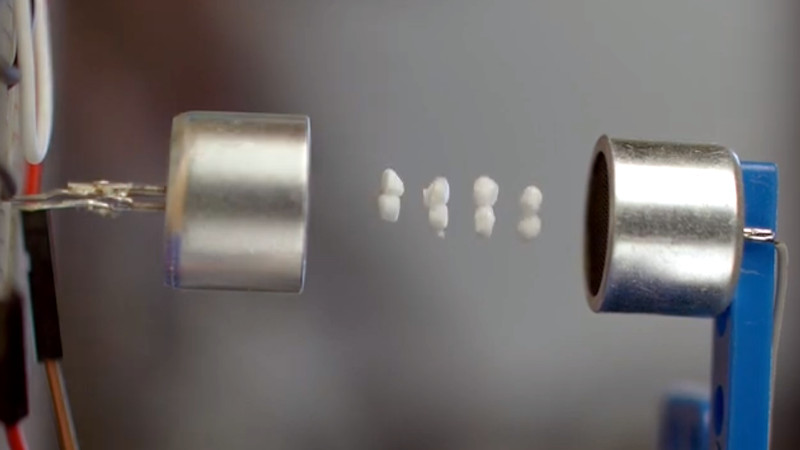Ultrasonic levitation — the practice of creating a standing wave between two ultrasonic sources and positioning lightweight objects such that they can float in the pressure minimums between them — has been a source of fascination to more than one experimenter. [Peter Lin] demonstrated this in the video below the break, by creating an ultrasonic levitation system using only the trusted chip of all true experimenters, the NE555. (Video, embedded below.)
The circuit is simplicity itself, just an astable of the type that has made a billion beepers and flashing LEDs. It drives two ultrasonic transducers in parallel, and with them pointing towards each other and a bit of gap adjustment work it can successfully levitate pieces of polystyrene. There was some work in adjusting the frequency to the transducer resonance, but that’s not a huge challenge given the right instrumentation. We can see that it would make a great demonstration of standing waves, and also a fantastic desk toy for not a lot.
We celebrate everyone’s favourite timer chip here at Hackaday, so much so that we recently ran a contest to find the best creations using it.

















Should have used a…. oh dang, nevermind.
I bet you could do this with a Raspberry Pi.
I agree, this was far to elegant, and simple, and robust, and reliable.
This totally reminds me of https://www.youtube.com/watch?v=B4pIJwy_ySY
At least have the rpi 4 (Needs that much computing power) to adjust the Potentiometer and the distance between the sensors. Come on now! Ha! :D. Really that is a nicely done elegant project. I like. Kudos.
I bet people do! I mean you can’t use a 555 because it has to have OMG analogue components.
Is that Owon handheld o’scope any good?
It’s only 20MHz and costs over $200. You can buy the 40MHz version (2C42) of this for $125 or the 70MHZ (2C72) for $150. Both can be had for slightly more with a built-in 25MHz arbitrary waveform generator option:
Testing the Hantek 2C42 $125 2-channel portable oscilloscope
Apr 2, 2022
https://www.youtube.com/watch?v=puWXEqVQ4Yk
Thanks
I own one (70MHz) and it’s great. There are comparisons of Owon and Hantek on YouTube.
I am wondering what would be a good application of such thing.
I’m thinking…
CO2 atmosphere + PLA powder + Transducers + Galvo Laser-Lighting + Programming = High Speed 3D Printing
I see possibilities..
That video is not “technology.” It’s ART! Well done.
Has anyone ever seen what happens to smoke in one of these things? Can you use it to visualize the (anti)nodes during tuning?
Hey!
I wanna see that too now.
Quick, someone do it and upload the video. Please!
I found this, I believe it should have this effect…
https://www.youtube.com/watch?app=desktop&v=XpNbyfxxkWE
https://m.youtube.com/watch?v=XpNbyfxxkWE